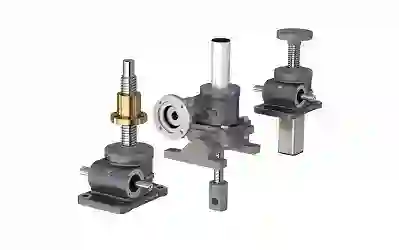Screw jacks are the unassuming heroes of the industrial world, silently powering vertical motion in countless applications. Yet, even these workhorses can be fine-tuned for optimal performance. Here’s how to unlock the full potential of screw jacks for your vertical movement needs:
Matching the Jack to the Job:
- Load Capacity: It all starts with choosing the right screw jack for the task. Select a jack with a load capacity exceeding the weight it will be lifting or pushing. Overloading can damage the jack and compromise safety.
- Travel Distance: Consider the required vertical travel distance for your application. Screw jacks come in various lead screw lengths, translating to different travel distances per rotation. Choose a jack with sufficient travel to meet your needs.
- Speed Requirements: While not their forte, some screw jack models offer variable speeds through the use of motors with adjustable gear ratios. Analyze your application’s speed requirements to find the optimal balance between speed and lifting capacity.
Maximizing Efficiency:
- Friction Reduction: Friction can lead to energy loss and heat generation in screw jacks. Consider using lubricants specifically designed for screw jacks to minimize friction and improve efficiency.
- Self-Lubricating Materials: For applications requiring minimal maintenance, explore screw jacks with components made from self-lubricating materials. These materials reduce the need for frequent lubrication.
- Regenerative Drive Systems: For specific applications, consider screw jack systems with regenerative drive technologies. These systems capture energy during lowering operations, potentially improving overall system efficiency.
Optimizing Performance:
- Environmental Considerations: Temperature extremes, dust, or moisture can impact screw jack performance. Choose a jack with appropriate material selection and sealing features to withstand your operating environment.
- Anti-Backlash Mechanisms: For applications requiring precise positioning, consider screw jacks with anti-backlash mechanisms. These eliminate unwanted play in the system, ensuring accurate vertical movement.
- Sensor Integration: Advanced screw jacks can be equipped with sensors. These sensors provide real-time data on load, position, and temperature, enabling performance optimization and predictive maintenance.
Beyond the Hardware:
- Proper Installation: A secure and level foundation is crucial for optimal screw jack performance. Improper installation can lead to instability and reduced efficiency.
- Maintenance Matters: Regular maintenance, as outlined in the manufacturer’s manual, ensures smooth operation and extends the lifespan of your screw jack.
- Operator Training: Providing proper training to personnel on the safe operation and capabilities of the screw jack promotes efficient use and avoids misuse.
Conclusion:
By carefully considering these optimization strategies, you can transform your screw jacks from workhorses into finely tuned machines for vertical movement. Matching the jack to the job, maximizing efficiency, optimizing performance, and prioritizing proper installation and maintenance will unlock the full potential of screw jacks, contributing to a more reliable, efficient, and safe operation.

Leave a Reply